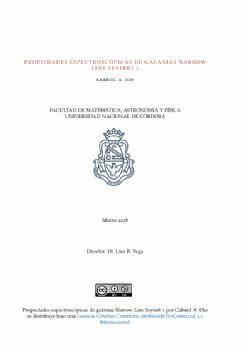| dc.contributor.advisor | Vega Neme, Luis Rodolfo | |
| dc.contributor.author | Oio, Gabriel Andrés | |
| dc.date.accessioned | 2021-08-05T15:12:34Z | |
| dc.date.available | 2021-08-05T15:12:34Z | |
| dc.date.issued | 2018 | |
| dc.identifier.uri | http://hdl.handle.net/11086/19315 | |
| dc.description | Tesis (Doctor en Astronomía)--Universidad Nacional de Córdoba, Facultad de Matemática, Astronomía, Física y Computación, 2018. | es |
| dc.description.abstract | Los núcleos activos de galaxias (AGN) se diferencian de las galaxias "normales" por el hecho de emitir una fracción significativa de energía que no puede ser explicada como resultado de procesos estelares. Esta fracción, proveniente de una región central muy compacta de la galaxia, es muy difícil de cuantificar. Los AGN del tipo "Narrow Line Seyfert 1" (NLS1) son una subclase de AGN con características de Seyfert 1 pero sin líneas anchas evidentes, lo cual implica grandes interrogantes sobre su estructura, dinámica y fuente central de excitación. A este tipo de galaxias se las define con el criterio de que el ancho a mitad de altura (FWHM) de la componente ancha de Hβ sea menor que 2000 km s-1 y que el cociente [OIII]λ5007/Hβ sea menor que 3. El estudio de los NLS1 puede brindarnos importante información sobre la evolución de los AGN y los mecanismos de ionización dominantes en las regiones más internas de estos objetos. Para estudiar estos objetos, seleccionamos una muestra de espectros a z < 0,1 obtenidos a partir del Sloan Digital Sky Survey. Utilizando la técnica de la síntesis espectral, separamos las diferentes componentes que contribuyen al espectro observado, a saber la componente estelar y no-estelar, y también la emisión del gas ionizado. En este trabajo se pretende cuantificar la contribución del núcleo activo al total del flujo observado y determinar el índice espectral más representativo en la región óptica del espectro en las galaxias NLS1. A partir de la técnica de síntesis espectral, también obtuvimos información sobre las diferentes poblaciones estelares presentes en estas galaxias. Por medio del espectro de emisión del gas, se determinó la dinámica y luminosidad de diferentes líneas de emisión, con las cuales estimamos masas de agujeros negros y tasas de acreción. Por último, se presenta un estudio detallado de la dinámica del gas y en particular de los vientos en la región central de la galaxia SDSS J093643.13+505249.6. Para ello se realizaron observaciones utilizando el Gemini Multi-Object Spectrographs con el Integral Field Unit (GMOS – IFU) en la región de Hβ + [OIII]λ5007 del espectro. De esta manera, obtuvimos mapas de flujo y de velocidades de estas líneas de emisión, con los cuales estimamos la extensión de los vientos en la región central de esta galaxia. | es |
| dc.description.abstract | Active galactic nuclei (AGN) differ from "normal" galaxies in that they emit a significant fraction of energy that cannot be explained as the result of stellar processes. This fraction, coming from a very compact central region of the galaxy, is very difficult to quantify. Narrow Line Seyfert 1 (NLS1) AGNs are a subclass of AGNs with Seyfert 1 characteristics but without obvious broad lines, which implies big questions about their structure, dynamics and central source of excitation. These types of galaxies are defined by the criterion that the width at half maximum (FWHM) of the broad Hβ component is less than 2000 km s-1 and that the [OIII]λ5007/Hβ ratio is less than 3. The study of NLS1s can provide us with important information about the evolution of AGNs and the dominant ionization mechanisms in the innermost regions of these objects. To study these objects, we selected a sample of spectra at z < 0.1 obtained from the Sloan Digital Sky Survey. Using the spectral synthesis technique, we separate the different components contributing to the observed spectrum, namely the stellar and non-stellar component, and also the emission from ionized gas. In this work we aim to quantify the contribution of the active nucleus to the total observed flux and to determine the most representative spectral index in the optical region of the spectrum in NLS1 galaxies. From the spectral synthesis technique, we also obtained information about the different stellar populations present in these galaxies. By means of the gas emission spectra, we determined the dynamics and luminosity of different emission lines, with which we estimate black hole masses and accretion rates. Finally, a detailed study of the gas dynamics and in particular of the winds in the central region of the galaxy SDSS J093643.13+505249.6 is presented. For this purpose, observations were made using the Gemini Multi-Object Spectrographs with the Integral Field Unit (GMOS - IFU) in the Hβ + [OIII]λ5007 region of the spectrum. In this way, we obtained flux and velocity maps of these emission lines, with which we estimated the extent of the winds in the central region of this galaxy. | en |
| dc.language.iso | spa | es |
| dc.rights | Atribución-NoComercial 4.0 Internacional | * |
| dc.rights.uri | http://creativecommons.org/licenses/by-nc/4.0/ | * |
| dc.subject | Galaxias activas | es |
| dc.subject | Espectroscopía | es |
| dc.subject | Agujeros negros | es |
| dc.subject | Galaxias: cinemática y dinámica | es |
| dc.subject | Observation and data reduction techniques; computer modeling and simulation | en |
| dc.subject | Spectroscopy and spectrophotometry | en |
| dc.subject | Active and peculiar galaxies and related systems | en |
| dc.subject | Galactic nuclei | en |
| dc.title | Propiedades espectroscópicas de galaxias Narrow Line Seyfert 1 | es |
| dc.type | doctoralThesis | es |
| dc.description.version | publishedVersion | |
| dc.description.fil | Fil: Oio, Gabriel Andrés. Universidad Nacional de Córdoba. Facultad de Matemática, Astronomía, Física y Computación; Argentina. | es |





